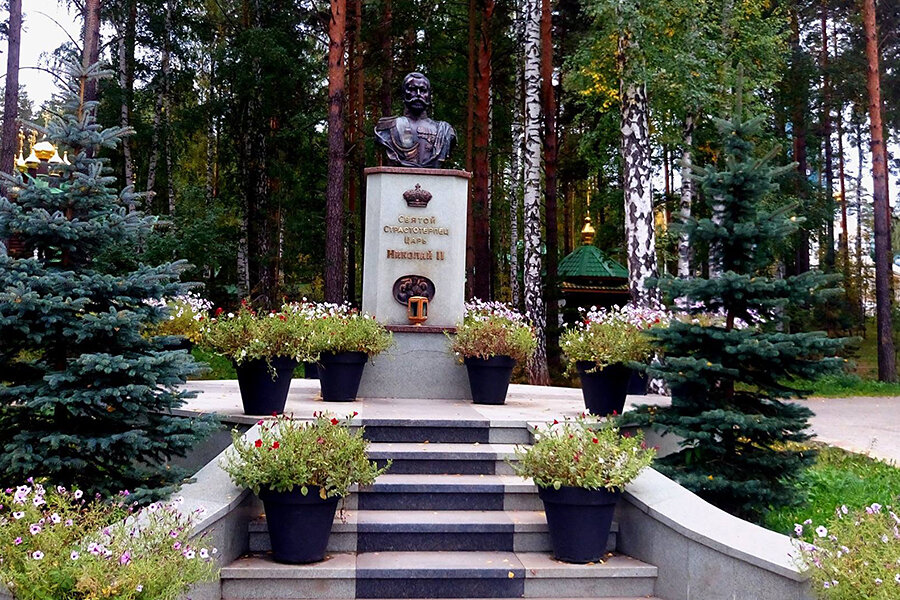A once-vilified czar returns to relevance in modern Russia
Loading...
| YEKATERINBURG, Russia
It has been almost a century since Nicholas II, Russia's last czar, was murdered along with his family by revolutionary Bolsheviks in the basement of a house in this gritty, industrial Urals city.
But nearly everyone in Yekaterinburg has an opinion about the man.
Nicholas II and his family have since been lavishly memorialized by the Russian Orthodox Church with the full backing of the Kremlin, after 70 years of the Soviet regime covering up his murder and secret burial. Some are critical of all the money being spent on churches and a vast monastery complex just out of town, designed to be places of pilgrimage to the late czar, whom the church has recently canonized as a saint.
Others argue that it's necessary for all Russians, whether religious or not, to honestly confront Russia's violent and fragmented past, if only to knit together an integral narrative that everyone can basically live with.
This is not a dry academic issue. Over the past century, two mighty Russian states have collapsed, leaving chaos and disillusionment in their wake. Both were highly centralized, ideologically driven systems of one-man rule. And after a brief fling with Western-style democracy in the 1990s, which which was accompanied by economic cataclysm and social despair, Vladimir Putin has reinvented a milder version of the traditional Russian autocratic state.
But, ironically, Putin's design closely resembles the setup during the last years of the deposed Czar Nicholas II. And looking into history's rear-view mirror, there is no obvious reason why current Kremlin leaders might not share the fate of czars and Soviets, should things take a serious turn for the worse.
"So far, Russians appear content with their bad institutions, though at this point it's basically because they fear things getting worse," says Andrei Kolesnikov, an expert with the Moscow Carnegie Center. "But fundamentally this is an authoritarian system, and our experience shows that if people's moods change drastically, they will turn out to have no special love for it."
Managing nostalgia
Mr. Putin has constructed an elaborate but heavily stage-managed multiparty parliamentary system that has so far reliably validated the incumbent authorities. It does not promote any strong ideology (although the Orthodox Church seems eager to fill that void), and Russians today enjoy far more personal freedoms, including freedom of speech, travel, and access to information, than any of their ancestors.
Though economic growth has stalled in recent years, the first decade of this century also saw an unprecedented expansion of relative mass prosperity. It is no wonder that Mr. Putin's personal popularity ratings hover above 80 percent.
Yet the issue of political legitimacy still looms large over today's Kremlin. And a description of Putin's current ruling construct – where a talking-shop legislature is dominated by a strong ruler who determines all strategic issues, including economic direction, foreign policy, and waging war – fits equally well with Nicholas's final court.
But Putin has made a radical departure from the approach of all previous Russian regimes, which was to discredit and revile their predecessors, by seeking to symbolically reconcile with them. He has catered to widespread Soviet nostalgia, particularly among older people, by bringing back the old Soviet national anthem and a variety of other familiar symbols, and often praising the achievements of the former USSR.
Looking toward the fast-approaching centenary of the Russian Revolution, which ousted czarism, the Kremlin has funded a variety of initiatives, including a huge new museum dedicated to the czarist epoch in Moscow's main exhibition grounds.
"The official attitude toward Russian history today is that it was all good," says Nikolai Svanidze, a historian and leading TV personality. "Our present leaders present themselves as being of one piece with the entire pageant of Russia's glorious and victorious past."
Honoring the Romanovs
Here in the distant Urals, the Kremlin has backed the church's grand projects to memorialize the last czar.
Following the Bolshevik revolution, Nicholas II and his family were exiled to Yekaterinburg, where they lived in the home of a local merchant named Ipatiev. That is where local Bolsheviks, fearing the advance of counter-revolutionary forces, shot them in July 1918.
The Ipatiev house was torn down in 1977 by then local Communist Party leader Boris Yeltsin – almost certainly on orders from Moscow – over fears that it might become a shrine for secret supporters of the hated czars. On this spot has been erected an enormous Orthodox cathedral, with a lower chapel ostensibly marking the space of the basement where the family was murdered.
The mine shaft outside the city, named Ganina Yama, where the royal remains were first disposed of, has become the site of a vast monastery, with dozens of beautiful traditional wooden churches and monuments, and a large hotel to accommodate pilgrims. A second burial site, a few miles away in a small forest glade called Porosyonkov Log, has received far less attention.
Public opinion has also softened on the last czar. A tracking poll by the independent Levada Center in Moscow found that just 18 percent of Russians thought Nicholas II was "more good than bad" in 1999, but today that number sits at 30 percent. That does not, however, translate into increased support for the idea of monarchy, whose public backing has ticked down slightly, from 3 percent in 1990 to 2.8 percent last year, according to the Levada poll.
Still, it suggests some Russians are taking a new, perhaps clearer look at their history.
"As a historian, I feel deep, personal guilt that I spent much of my life unaware of the tragedy that happened here," says Yevgeny Roizman, Yekaterinburg's progressive mayor. "We were all subjected to an intense propaganda barrage designed to make the last Russian emperor look like a loser, and we now see that it was all aimed at trying to justify his murder."






